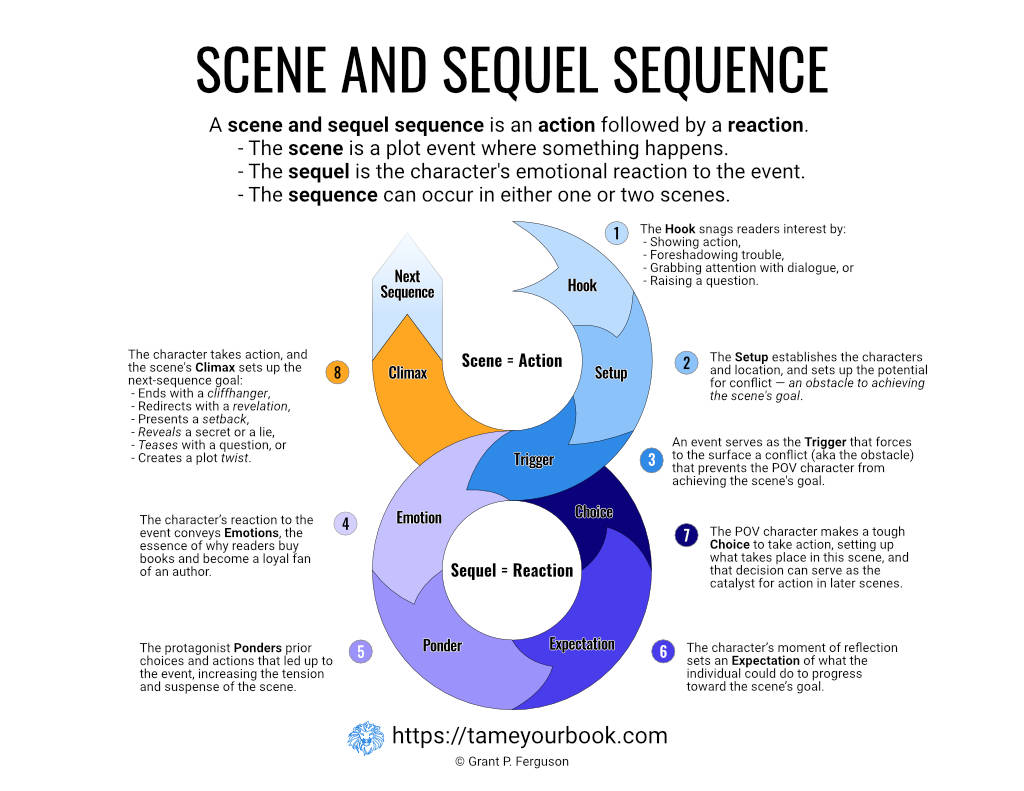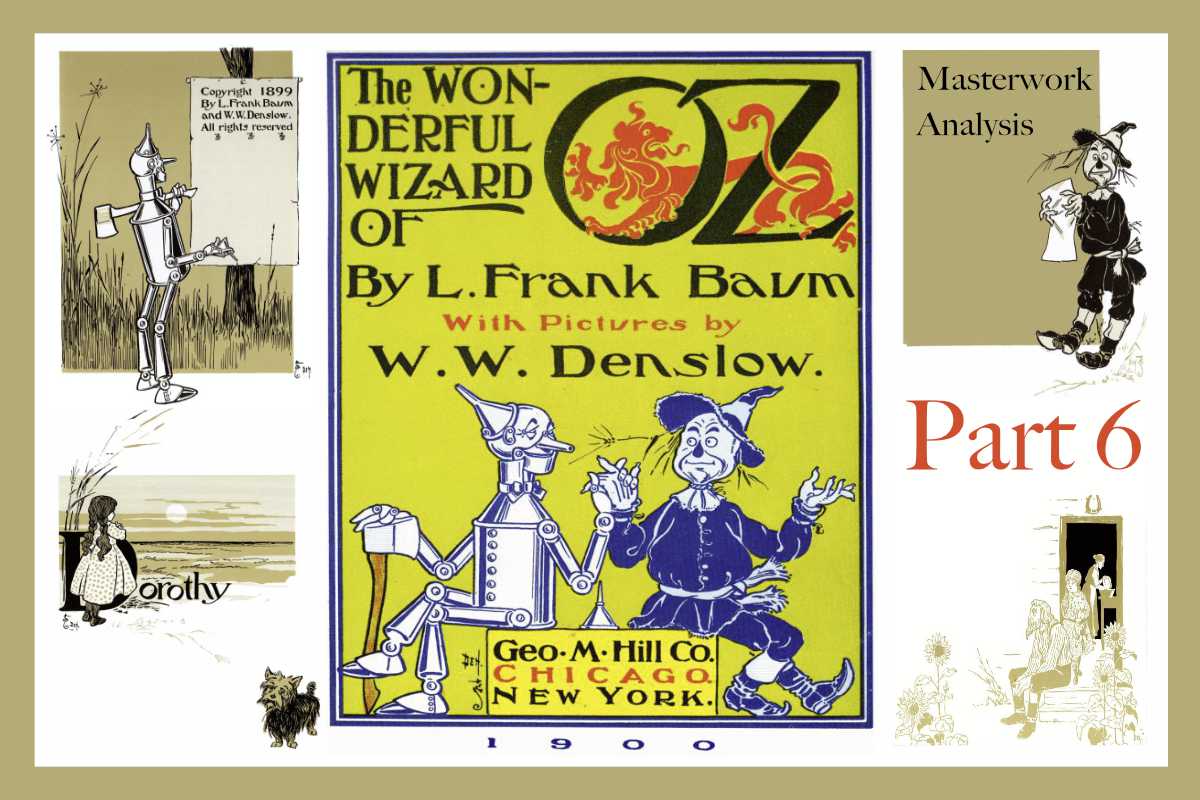By: Grant P. Ferguson
Last Updated: February 21, 2024
Robert McKee shared this wisdom. “Writing is a marathon, not a sprint.” The finish line is in sight for this series on L. Frank Baum’s action fantasy, The Wonderful Wizard of Oz. I’ll use the Phase I: Plan from the Trellis Method to emphasize essential story structure takeaways.
Recap from Prior Posts
The prior posts explain the process and Story Beats.
Premise
While researching The Wonderful Wizard of Oz book, I came across this humorous premise for an airing of The Wizard of Oz movie on TCM.
Transported to a surreal landscape, a young girl kills the first person she meets and then teams up with three strangers to kill again. — Rick Polito
Here’s my take on the book’s premise:
When a tornado whisks a curious young girl into the clouds, she arrives shaken yet uninjured in a strange land, where she and three companions face endless obstacles from witches, environment, and a bad wizard as she struggles to return home, and along the way she discovers the secret to her happiness.
Writing Principle: The narrative’s premise serves as the writer’s strategic compass as you follow the map marked by the Story Beats.
Characters
Baum’s strong characterization of Dorothy, Toto, Scarecrow, Tin Woodman, and Lion kept readers focused on the storyline despite introducing additional characters and conflicts. For more information, check out the free Character Template.
- Chief Protagonist
- Dorothy (Key Traits: Fairness and Protective; Need: Recognize Self-sufficiency)
- Co-Protagonists
- Scarecrow (Key Trait: Wisdom; Need: Recognize has Brains)
- Tin Woodman (Key Trait: Compassion; Need: Recognize has Heart)
- Cowardly Lion (Key Trait: Bold; Need: Recognize has Courage)
- Toto (Key Trait: Devoted / Selfless Love; Need: Reveal Truth with Curiosity)
- Glinda the Good Witch (Key Trait: Helper; Need: Show Dorothy her inner power)
The antagonists took the form of humans, creatures, and environment, each designed to draw out an emotional response from the protagonists and audience.
- Antagonists
- Black Bees
- Environment, including weather, broad/swift river, unfamiliar landscape, great distances to Kansas and Emerald City, scarlet poppies field, and great ditch/broad gulf.
- Fighting Trees
- Giant Spider
- Hammer-Heads
- Kalidahs
- Pack of Great Wolves
- Wicked Witch of the North
- Wicked Witch of the West
- Wild Crows
- Winged Monkeys
- Winkies (Dozen Slaves)
- The Wizard of Oz
The supporting cast members gave readers insights into the positive and negative traits of the protagonists.
- Supporting Cast
- Aunt Em (Dorothy’s Guardian)
- Uncle Henry (Dorothy’s Guardian)
- Boq
- China Clown
- China Milk-Maid
- China Princess
- Glinda (Gives Dorothy the secret to her happiness — the Internal Theme)
- Green Girl
- Guardian of the Gates
- Monkey King
- Munchkins
- Quadlings
- Queen of the Field Mice
- Soldier with Green Whiskers
- Stork
Writing Principle: Even when the co-protagonists share the spotlight with the chief protagonist, make clear who is the lead.
Plot
The Story Beats empower writers to simplify summarizing the first to last page of your novel in 1,000 to 1,500 words. For more information, take a look at the Story Plots Development Workbook.
Here’s an example of a beat-by-beat synopsis.

Writing Tips: Use the Story Beats to outline your novel’s scenes before writing, or perform an analysis afterwards. Either way, the combination of the synopsis and individual scene summaries helps you benchmark whether your story is working. Building a Story Spine and plotting the Story Body help you outline your story before you write. Also, you’ll find the creation of a beat-by-beat synopsis is not a once-and-done process. Instead, update the beats and scenes as you fix issues and come up with more ideas.

Themes
To learn more, get the Story Themes Development Workbook.
External
The external theme of the book is when home-life prevails, a person feels secure and loved. When the tornado whisked Dorothy away from Kansas, she was torn from her home life — the status quo (i.e., the stable world).
In scene 8, Dorothy reinforces the external theme in this statement to Scarecrow.
“No matter how dreary and gray our homes are, we people of flesh and blood would rather live there than in any other country, be it ever so beautiful. There is no place like home.”
Internal
Although not conclusive in the THRUST INTO 2 (scene 10), there are hints that the combination of Scarecrow, Tin Woodman, and Cowardly Lion will help Dorothy learn the inner theme: when self-sufficiency prevails, a person is not dependent on others to overcome adversity (i.e., the person is not a victim of circumstances).
In the PLUNGE INTO 3 (scene 37), Dorothy demonstrates she has learned the life lesson, and commits to overcome her situation.
“Suppose we call the field mice,” she suggested. “They could probably tell us the way to the Emerald City.”
In scene 38, Dorothy acts on her choice, highlighting how she is no longer the victim of circumstances.
In the CLIMAX (scene 51), the Good Witch Glinda confirms that Dorothy already had the power of the silver shoes to take her back home, but even if she had possessed that knowledge, she also had to exercise her self-sufficiency with a decision and action — an excellent lesson for Baum’s target audience: young readers.
“Your Silver Shoes will carry you over the desert,” replied Glinda. “If you had known their power you could have gone back to your Aunt Em the very first day you came to this country.”
The characters confirm the truth of Glinda’s statement, and highlight how experiences teach valuable life lessons.
- “But then I should not have had my wonderful brains!” cried the Scarecrow. “I might have passed my whole life in the farmer’s cornfield.”
- “And I should not have had my lovely heart,” said the Tin Woodman. “I might have stood and rusted in the forest till the end of the world.”
- “And I should have lived a coward forever,” declared the Lion, “and no beast in all the forest would have had a good word to say to me.”
- “This is all true,” said Dorothy, “and I am glad I was of use to these good friends. But now that each of them has had what he most desired, and each is happy in having a kingdom to rule besides, I think I should like to go back to Kansas.”
Philosophical
The philosophical theme is when good prevails, evil no longer has power over individuals. In scene 5, the “good witch” contrasts with the “wicked witch.”
Additional scenes emphasize good versus evil. For example, in scene 33, the leader of the Winged Monkey makes clear the overarching philosophical theme.
“We dare not harm this little girl,” he said to them, “for she is protected by the Power of Good, and that is greater than the Power of Evil. All we can do is to carry her to the castle of the Wicked Witch and leave her there.”
Writing Tips: Study your chosen genre to determine dominant themes. Don’t worry about coming up with a new one. Themes are universal life lessons, and readers want to learn and experience the world vicariously through the thoughts, decisions, words, actions, and emotions of your characters.
Structure
Structure the Beats within in Scenes
Baum included essential beats within scenes.

Writing Tips: Track the Scene & Sequel Sequence Beats for each scene. Scrivener simplifies the process with the Custom Metadata feature, but you can do the same thing by making comments in your MS Word document or using a spreadsheet to track the information scene by scene. This habit will create scene-by-scene summaries for your entire novel.
Structure Scene Order and Pacing
The author ordered the scenes in a pattern that challenged the protagonist and co-protagonists to go through a try-and-fail cycle repeatedly. Each cycle raised the stakes, escalating the potential for physical, professional, or psychological death.
- Act 1: Dorothy and Toto faced a life-threatening tornado, including her emotional death if she cannot find a way home.
- Act 2: Dorothy and friends fought for their lives many times, and all faced emotional death if they could not achieve their heart’s desires.
- Act 3: The protagonist and co-protagonists faced physical and emotional deaths, and the Wizard of Oz faced professional death if exposed as a fraud.
Because Baum used the try-and-fail cycle throughout the book, the ebb and flow of tension increased until its release in the RESOLUTION.
In the story, conflict resulted from opposing forces, including characters, nature, self, society, supernatural, and technology (e.g., Wizards Throne Room and his balloon). Tension occurred as readers expected more conflict. Suspense grew as the conflict remained unresolved, and readers wondered, What will happen next to Dorothy and her friends?
Writing Tips: Story Beats help writers organize their stories, but genres suggest essential scenes, conventions, and tropes. Authors remain in control of what and where they place content. Just like a map, Story Beats show the most direct route to a desired destination; however, detours can entertain, inform, and inspire! The Story Genres Development Workbook walks you through the steps.
Structure Point of View
Except for scene 37 (i.e., the beginning of Chapter 14), where Baum briefly uses second person, the story is told from the third-person omniscient narrator point of view.
According to reedsy.com, “Third person omniscient is the point of view where the narrator takes a ‘God’s Eye View,’ freely relating the thoughts of any character and any part of the backstory. The word literally means ‘all-knowing,’ so third-person omniscient narrators are not usually active characters in the story but have an external narrative voice.” It’s probably the oldest form of storytelling.
In contrast, second person point of view, the author directly addresses the reader by using the pronoun ‘you.’
Writing Tips: Make your point of view choice before writing to save time and frustration. For example, switching from first person to third person requires rewriting. Also, readers often associate a point of view with a genre. Baum’s choice to use third person omniscient aligns with the action fantasy genre. In contrast, many authors use third-person limited for thrillers and mysteries, where the narrative viewpoint is told from the close perspective of one character.
Series Wrap Up on Structure
The Wonderful Wizard of Oz continues to delight readers of all ages. For writers, this masterwork is worthy of in-depth study, especially Baum’s consistent and artful use of beats to capture and hold the audience’s attention.
Related Posts
1. Do You Want to Personalize Story Structure? Now You Can! – Part 1
2. Do You Want to Personalize Story Structure? Now You Can! – Part 2
3. Do You Want to Personalize Story Structure? Now You Can! – Part 3
4. Do You Want to Personalize Story Structure? Now You Can! – Part 4
5. Do You Want to Personalize Story Structure? Now You Can! – Part 5
6. Do You Want to Personalize Story Structure? Now You Can! – Part 6
Resources
Leave a Reply
I value your feedback, so let me know what you think!
What other masterworks have you studied? Your recommendation for another deep dive?


Leave a Reply